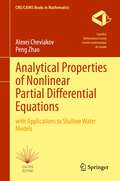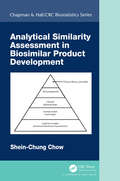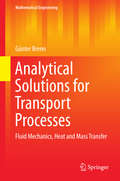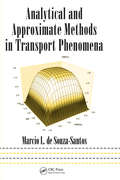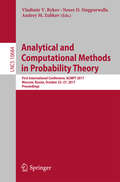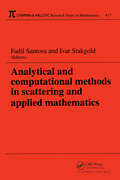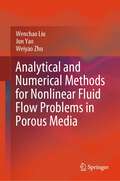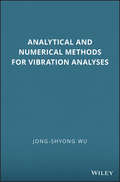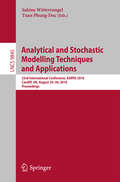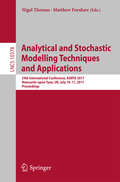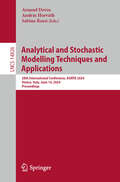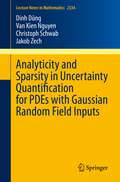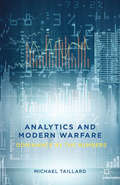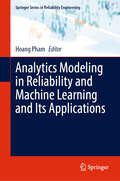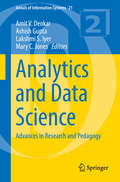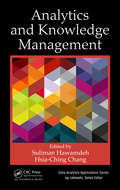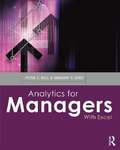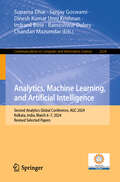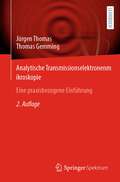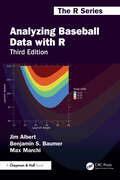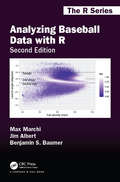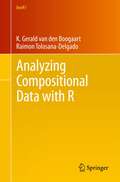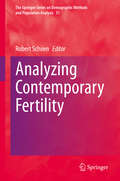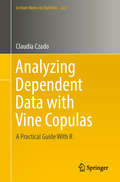- Table View
- List View
Analytical Properties of Nonlinear Partial Differential Equations: with Applications to Shallow Water Models (CMS/CAIMS Books in Mathematics #10)
by Alexei Cheviakov Shanghai Maritime UniversityNonlinear partial differential equations (PDE) are at the core of mathematical modeling. In the past decades and recent years, multiple analytical methods to study various aspects of the mathematical structure of nonlinear PDEs have been developed. Those aspects include C- and S-integrability, Lagrangian and Hamiltonian formulations, equivalence transformations, local and nonlocal symmetries, conservation laws, and more. Modern computational approaches and symbolic software can be employed to systematically derive and use such properties, and where possible, construct exact and approximate solutions of nonlinear equations. This book contains a consistent overview of multiple properties of nonlinear PDEs, their relations, computation algorithms, and a uniformly presented set of examples of application of these methods to specific PDEs. Examples include both well known nonlinear PDEs and less famous systems that arise in the context of shallow water waves and far beyond. The book will beof interest to researchers and graduate students in applied mathematics, physics, and engineering, and can be used as a basis for research, study, reference, and applications.
Analytical Similarity Assessment in Biosimilar Product Development
by Shein-Chung ChowThis book focuses on analytical similarity assessment in biosimilar product development following the FDA’s recommended stepwise approach for obtaining totality-of-the-evidence for approval of biosimilar products. It covers concepts such as the tiered approach for assessment of similarity of critical quality attributes in the manufacturing process of biosimilar products, models/methods like the statistical model for classification of critical quality attributes, equivalence tests for critical quality attributes in Tier 1 and the corresponding sample size requirements, current issues, and recent developments in analytical similarity assessment.
Analytical Solutions for Transport Processes: Fluid Mechanics, Heat and Mass Transfer (Mathematical Engineering)
by Günter BrennThis monograph provides analytical solutions to a number of classical problems in transport processes, i. e. in fluid mechanics, heat and mass transfer. Increasing computing power and efficient numerical methods have increased the importance of computational tools. However, the interpretation of these results is often difficult and the computational results need to be tested against the analytical results. This is why the analytical solutions are of high value. Furthermore, analytical solutions for transport processes provide a much deeper understanding of the physical phenomena of a given process than the corresponding numerical solution. The target audience primarily comprises researcher and practitioners but the book may also be beneficial for graduate students who want to enter the field.
Analytical and Approximate Methods in Transport Phenomena
by Marcio L. de Souza-SantosOn the job or in the field, when facing a problem with differential equations and boundary conditions, most likely you don't have time to read through several publications in search of a method that may or may not solve your problem. Organized for quick and easy access to practical solutions, Analytical and Approximate Methods in Transport Pheno
Analytical and Computational Methods in Probability Theory: First International Conference, ACMPT 2017, Moscow, Russia, October 23-27, 2017, Proceedings (Lecture Notes in Computer Science #10684)
by Vladimir V. Rykov Nozer D. Singpurwalla Andrey M. ZubkovThis book constitutes the refereed proceedings of the First International Conference on Analytical and Computational Methods in Probability Theory and its Applications, ACMPT 2017, held in Moscow, Russia, in October 2017. The 42 full papers presented were carefully reviewed and selected from 173 submissions. The conference program consisted of four main themes associated with significant contributions made by A. D. Soloviev. These are: Analytical methods in probability theory, Computational methods in probability theory, Asymptotical methods in probability theory, the history of mathematics.
Analytical and Computational Methods in Scattering and Applied Mathematics (Chapman & Hall/CRC Research Notes in Mathematics Series #No. 417)
by Fadil Santosa Ivar StakgoldProfessor Ralph Kleinman was director of the Center for the Mathematics of Waves and held the UNIDEL Professorship of the University of Delaware. Before his death in 1998, he made major scientific contributions in the areas of electromagnetic scattering, wave propagation, and inverse problems. He was instrumental in bringing together the mathematic
Analytical and Numerical Methods for Nonlinear Fluid Flow Problems in Porous Media
by Weiyao Zhu Jun Yao Wenchao LiuThis book investigates in detail the mathematical methods and computation methods in efficient solution of some open nonlinear seepage flow problems involved in engineering problems. Developed engineering technologies and some relevant practical field applications are also provided. The introduced open nonlinear problems include nonlinear quadratic pressure gradient term problem, compressible gas seepage flow problem and low-velocity non-Darcy seepage flow problem. Studies on these nonlinear seepage flow problems have attracted engineers and scientists from various disciplines, such as geo-energy engineering, civil and environmental engineering, fluid mechanics, applied mathematics and computation. In particular, the book systematically establishes a fundamental theory for a strongly nonlinear problem of low-velocity non-Darcy seepage flow from a new perspective of moving boundary, while emphasizing the usage of mathematical linearization transformation methods and computational methods into the analytical and numerical solution of the strongly nonlinear partial differential equations. Sufficient knowledge of mathematics is always introduced ahead of model solution to assist readers. And the procedure of strict formula deduction in the model solution process is provided in detail. High-solution figures and tables from model solution are rich in the book. Therefore, it is very helpful for the readers to master the nonlinear model solution methods and engineering technologies. The book is intended for upper undergraduate students and graduate students who are interested in engineering technology, fluid mechanics and applied mathematics, researchers and engineers working on geo-energy science and engineering and field applications.
Analytical and Numerical Methods for Vibration Analyses
by Jong-Shyong WuIllustrates theories and associated mathematical expressions with numerical examples using various methods, leading to exact solutions, more accurate results, and more computationally efficient techniques This book presents the derivations of the equations of motion for all structure foundations using either the continuous model or the discrete model. This mathematical display is a strong feature of the book as it helps to explain in full detail how calculations are reached and interpreted. In addition to the simple 'uniform' and 'straight' beams, the book introduces solution techniques for the complicated ‘non uniform’ beams (including linear or non-linear tapered beams), and curved beams. Most of the beams are analyzed by taking account of the effects of shear deformation and rotary inertia of the beams themselves as well as the eccentricities and mass moments of inertia of the attachments. Demonstrates approaches which dramatically cut CPU times to a fraction of conventional FEM Presents "mode shapes" in addition to natural frequencies, which are critical for designers Gives detailed derivations for continuous and discrete model equations of motions Summarizes the analytical and numerical methods for the natural frequencies, mode shapes, and time histories of straight structures rods shafts Euler beams strings Timoshenko beams membranes/thin plates Conical rods and shafts Tapered beams Curved beams Has applications for students taking courses including vibration mechanics, dynamics of structures, and finite element analyses of structures, the transfer matrix method, and Jacobi method This book is ideal for graduate students in mechanical, civil, marine, aeronautical engineering courses as well as advanced undergraduates with a background in General Physics, Calculus, and Mechanics of Material. The book is also a handy reference for researchers and professional engineers.
Analytical and Stochastic Modelling Techniques and Applications: 23rd International Conference, ASMTA 2016, Cardiff, UK, August 24-26, 2016, Proceedings (Lecture Notes in Computer Science #9845)
by Sabine Wittevrongel Tuan Phung-DucThis book constitutes the refereed proceedings of the 23rd International Conference on Analytical and Stochastic Modelling Techniques and Applications, ASMTA 2016, held in Cardiff, UK, in August 2016. The 21 full papers presented in this book were carefully reviewed and selected from 30 submissions. The papers discuss the latest developments in analytical, numerical and simulation algorithms for stochastic systems, including Markov processes, queueing networks, stochastic Petri nets, process algebras, game theory, etc.
Analytical and Stochastic Modelling Techniques and Applications: 24th International Conference, ASMTA 2017, Newcastle-upon-Tyne, UK, July 10-11, 2017, Proceedings (Lecture Notes in Computer Science #10378)
by Nigel Thomas Matthew ForshawThis book constitutes the refereed proceedings of the 24th International Conference on Analytical and Stochastic Modelling Techniques and Applications, ASMTA 2017, held in Newcastle-upon-Tyne UK, in July 2017.The 14 full papers presented in this book were carefully reviewed and selected from 27 submissions. The scope of the conference is on following topics: analytical, numerical and simulation algorithms for stochastic systems, including Markov processes, queueing networks, stochastic Petri nets, process algebras, game theoretical models.
Analytical and Stochastic Modelling Techniques and Applications: 25th International Conference, ASMTA 2019, Moscow, Russia, October 21–25, 2019, Proceedings (Lecture Notes in Computer Science #12023)
by Marco Gribaudo Eduard Sopin Irina KochetkovaThis book constitutes the refereed proceedings of the 25th International Conference on Analytical and Stochastic Modelling Techniques and Applications, ASMTA 2019, held in Moscow, Russia, in October 2019. Methods of analytical and stochastic modelling are widely used in engineering to assess and design various complex systems, like computer and communication networks, and manufacturing systems. The 13 full papers presented in this book were carefully reviewed and selected from 22 submissions. The papers detail a diverse range of analysis techniques, including Markov processes, queueing theoretical results, reliability of stochastic systems, stochastic network calculus, and wide variety of applications.
Analytical and Stochastic Modelling Techniques and Applications: 28th International Conference, ASMTA 2024, Venice, Italy, June 14, 2024, Proceedings (Lecture Notes in Computer Science #14826)
by András Horváth Arnaud Devos Sabina RossiThis book constitutes the refereed proceedings of the 28th International Conference on Analytical and Stochastic Modelling Techniques and Applications, ASMTA 2024, held in Venice, Italy, on June 14, 2024. The 10 full papers presented were carefully reviewed and selected from 14 submissions. These papers covered a wide range of topics in analytical and stochastic modeling techniques and their applications.
Analyticity and Sparsity in Uncertainty Quantification for PDEs with Gaussian Random Field Inputs (Lecture Notes in Mathematics #2334)
by Christoph Schwab Dinh Dũng Van Kien Nguyen Jakob ZechThe present book develops the mathematical and numerical analysis of linear, elliptic and parabolic partial differential equations (PDEs) with coefficients whose logarithms are modelled as Gaussian random fields (GRFs), in polygonal and polyhedral physical domains. Both, forward and Bayesian inverse PDE problems subject to GRF priors are considered.Adopting a pathwise, affine-parametric representation of the GRFs, turns the random PDEs into equivalent, countably-parametric, deterministic PDEs, with nonuniform ellipticity constants. A detailed sparsity analysis of Wiener-Hermite polynomial chaos expansions of the corresponding parametric PDE solution families by analytic continuation into the complex domain is developed, in corner- and edge-weighted function spaces on the physical domain.The presented Algorithms and results are relevant for the mathematical analysis of many approximation methods for PDEs with GRF inputs, such as model order reduction, neural network and tensor-formatted surrogates of parametric solution families. They are expected to impact computational uncertainty quantification subject to GRF models of uncertainty in PDEs, and are of interest for researchers and graduate students in both, applied and computational mathematics, as well as in computational science and engineering.
Analytics And Modern Warfare: Dominance by the Numbers
by Michael TaillardThis book details very simply and for even the most novice of potential analysts not only how to perform analytics which describe what is happening, predict what is going to happen, and optimize responses, but also places these analytics in the context of proactive strategy development.
Analytics Modeling in Reliability and Machine Learning and Its Applications (Springer Series in Reliability Engineering)
by Hoang PhamThis book presents novel research and application chapters on topics in reliability, statistics, and machine learning. It has an emphasis on analytical models and techniques and practical applications in reliability engineering, data science, manufacturing, health care, and industry using machine learning, AI, optimization, and other computational methods. Today, billions of people are connected to each other through their mobile devices. Data is being collected and analysed more than ever before. The era of big data through machine learning algorithms, statistical inference, and reliability computing in almost all applications has resulted in a dramatic shift in the past two decades. Data analytics in business, finance, and industry is vital. It helps organizations and business to achieve better results and fact-based decision-making in all aspects of life. The book offers a broad picture of current research on the analytics modeling and techniques and its applications in industry. Topics include: l Reliability modeling and methods. l Software reliability engineering. l Maintenance modeling and policies. l Statistical feature selection. l Big data modeling. l Machine learning: models and algorithms. l Data-driven models and decision-making methods. l Applications and case studies in business, health care, and industrial systems. Postgraduates, researchers, professors, scientists, engineers, and practitioners in reliability engineering and management, machine learning engineering, data science, operations research, industrial and systems engineering, statistics, computer science and engineering, mechanical engineering, and business analytics will find in this book state-of-the-art analytics, modeling and methods in reliability and machine learning.
Analytics and Data Science: Advances in Research and Pedagogy (Annals of Information Systems #21)
by Ashish Gupta Lakshmi S. Iyer Amit V. Deokar Mary C. JonesThis book explores emerging research and pedagogy in analytics and data science that have become core to many businesses as they work to derive value from data. The chapters examine the role of analytics and data science to create, spread, develop and utilize analytics applications for practice. Selected chapters provide a good balance between discussing research advances and pedagogical tools in key topic areas in analytics and data science in a systematic manner. This book also focuses on several business applications of these emerging technologies in decision making, i. e. , business analytics. The chapters in Analytics and Data Science: Advances in Research and Pedagogy are written by leading academics and practitioners that participated at the Business Analytics Congress 2015. Applications of analytics and data science technologies in various domains are still evolving. For instance, the explosive growth in big data and social media analytics requires examination of the impact of these technologies and applications on business and society. As organizations in various sectors formulate their IT strategies and investments, it is imperative to understand how various analytics and data science approaches contribute to the improvements in organizational information processing and decision making. Recent advances in computational capacities coupled by improvements in areas such as data warehousing, big data, analytics, semantics, predictive and descriptive analytics, visualization, and real-time analytics have particularly strong implications on the growth of analytics and data science.
Analytics and Knowledge Management (Data Analytics Applications)
by Suliman Hawamdeh and Hsia-Ching ChangThe process of transforming data into actionable knowledge is a complex process that requires the use of powerful machines and advanced analytics technique. Analytics and Knowledge Management examines the role of analytics in knowledge management and the integration of big data theories, methods, and techniques into an organizational knowledge management framework. Its chapters written by researchers and professionals provide insight into theories, models, techniques, and applications with case studies examining the use of analytics in organizations. The process of transforming data into actionable knowledge is a complex process that requires the use of powerful machines and advanced analytics techniques. Analytics, on the other hand, is the examination, interpretation, and discovery of meaningful patterns, trends, and knowledge from data and textual information. It provides the basis for knowledge discovery and completes the cycle in which knowledge management and knowledge utilization happen. Organizations should develop knowledge focuses on data quality, application domain, selecting analytics techniques, and on how to take actions based on patterns and insights derived from analytics. Case studies in the book explore how to perform analytics on social networking and user-based data to develop knowledge. One case explores analyze data from Twitter feeds. Another examines the analysis of data obtained through user feedback. One chapter introduces the definitions and processes of social media analytics from different perspectives as well as focuses on techniques and tools used for social media analytics. Data visualization has a critical role in the advancement of modern data analytics, particularly in the field of business intelligence and analytics. It can guide managers in understanding market trends and customer purchasing patterns over time. The book illustrates various data visualization tools that can support answering different types of business questions to improve profits and customer relationships. This insightful reference concludes with a chapter on the critical issue of cybersecurity. It examines the process of collecting and organizing data as well as reviewing various tools for text analysis and data analytics and discusses dealing with collections of large datasets and a great deal of diverse data types from legacy system to social networks platforms.
Analytics for Managers: With Excel
by Gregory S. Zaric Peter C. BellAnalytics is one of a number of terms which are used to describe a data-driven more scientific approach to management. Ability in analytics is an essential management skill: knowledge of data and analytics helps the manager to analyze decision situations, prevent problem situations from arising, identify new opportunities, and often enables many millions of dollars to be added to the bottom line for the organization. The objective of this book is to introduce analytics from the perspective of the general manager of a corporation. Rather than examine the details or attempt an encyclopaedic review of the field, this text emphasizes the strategic role that analytics is playing in globally competitive corporations today. The chapters of this book are organized in two main parts. The first part introduces a problem area and presents some basic analytical concepts that have been successfully used to address the problem area. The objective of this material is to provide the student, the manager of the future, with a general understanding of the tools and techniques used by the analyst.
Analytics, Machine Learning, and Artificial Intelligence: Second Analytics Global Conference, AGC 2024, Kolkata, India, March 6–7, 2024, Revised Selected Papers (Communications in Computer and Information Science #2224)
by Chandan Mazumdar Suparna Dhar Sanjay Goswami Indranil Bose Rameshwar Dubey Dinesh Kumar Unni KrishnanThis book constitutes the refereed proceedings of the Second Analytics Global Conference on Analytics, Machine Learning, and Artificial Intelligence, AGC 2024, held in Kolkata, India, during March 6-7, 2024. The 15 full papers and 3 short papers presented in these proceedings were carefully reviewed and selected from 60 submissions. The papers are organized in these topical sections: applications of analytics in business; analytics methods, tools & techniques.
Analytische Transmissionselektronenmikroskopie: Eine praxisbezogene Einführung
by Jürgen Thomas Thomas GemmingDas Buch wendet sich an alle, egal ob im Studium, in technischen Berufen, oder in der Wissenschaft, die die sich für die analytische Transmissionselektronenmikroskopie interessieren und einen Überblick über diese Methode erhalten möchten. Insbesondere betrifft dies Personen, die an einem Transmissionselektronenmikroskop arbeiten wollen oder müssen, die aber noch keine spezielle elektronenmikroskopische Ausbildung durchlaufen haben. Das Buch basiert auf den Erfahrungen der Autoren bei der Unterrichtung von Studierenden, Promovierenden und in technischen Berufen Tätigen. Der Überblick über die analytische Transmissionselektronenmikroskopie umfasst die Schwerpunkte Optische Abbildung, Elektronenwellen, magnetische Linsen, Abbildungsfehler, Aufbau eines Transmissionselektronenmikroskops, Präparation dünner Proben, Justage des Mikroskops, Elektronenbeugung, Kontrastentstehung, Höchstauflösungselektronenmikroskopie, Rastertransmissionselektronenmikroskopie sowie Analytik mittels energiedispersiver Röntgenspektroskopie und Elektronenenergieverlust-Spektroskopie. Ein mathematischer Anhang erklärt grundlegende Formalismen zur Thematik.
Analyzing Baseball Data with R (Chapman & Hall/CRC The R Series)
by Jim Albert Benjamin S. Baumer Max Marchi“Our community has continued to grow exponentially, thanks to those who inspire the next generation. And inspiring the next generation is what the authors of Analyzing Baseball Data with R are doing. They are setting the career path for still thousands more. We all need some sort of kickstart to take that first or second step. You may be a beginner R coder, but you need access to baseball data. How do you access this data, how do you manipulate it, how do you analyze it? This is what this book does for you. But it does more, by doing what sabermetrics does best: it asks baseball questions. Throughout the book, baseball questions are asked, some straightforward, and others more thought-provoking.”From the Foreword by Tom TangoAnalyzing Baseball Data with R Third Edition introduces R to sabermetricians, baseball enthusiasts, and students interested in exploring the richness of baseball data. It equips you with the necessary skills and software tools to perform all the analysis steps, from importing the data to transforming them into an appropriate format to visualizing the data via graphs to performing a statistical analysis.The authors first present an overview of publicly available baseball datasets and a gentle introduction to the type of data structures and exploratory and data management capabilities of R. They also cover the ggplot2 graphics functions and employ a tidyverse-friendly workflow throughout. Much of the book illustrates the use of R through popular sabermetrics topics, including the Pythagorean formula, runs expectancy, catcher framing, career trajectories, simulation of games and seasons, patterns of streaky behavior of players, and launch angles and exit velocities. All the datasets and R code used in the text are available for download online.New to the third edition is the revised R code to make use of new functions made available through the tidyverse. The third edition introduces three chapters of new material, focusing on communicating results via presentations using the Quarto publishing system, web applications using the Shiny package, and working with large data files. An online version of this book is hosted at https://beanumber.github.io/abdwr3e/.
Analyzing Baseball Data with R, Second Edition (Chapman & Hall/CRC The R Series #14)
by Jim Albert Benjamin S. Baumer Max MarchiAnalyzing Baseball Data with R Second Edition introduces R to sabermetricians, baseball enthusiasts, and students interested in exploring the richness of baseball data. It equips you with the necessary skills and software tools to perform all the analysis steps, from importing the data to transforming them into an appropriate format to visualizing the data via graphs to performing a statistical analysis. The authors first present an overview of publicly available baseball datasets and a gentle introduction to the type of data structures and exploratory and data management capabilities of R. They also cover the ggplot2 graphics functions and employ a tidyverse-friendly workflow throughout. Much of the book illustrates the use of R through popular sabermetrics topics, including the Pythagorean formula, runs expectancy, catcher framing, career trajectories, simulation of games and seasons, patterns of streaky behavior of players, and launch angles and exit velocities. All the datasets and R code used in the text are available online. New to the second edition are a systematic adoption of the tidyverse and incorporation of Statcast player tracking data (made available by Baseball Savant). All code from the first edition has been revised according to the principles of the tidyverse. Tidyverse packages, including dplyr, ggplot2, tidyr, purrr, and broom are emphasized throughout the book. Two entirely new chapters are made possible by the availability of Statcast data: one explores the notion of catcher framing ability, and the other uses launch angle and exit velocity to estimate the probability of a home run. Through the book’s various examples, you will learn about modern sabermetrics and how to conduct your own baseball analyses. Max Marchi is a Baseball Analytics Analyst for the Cleveland Indians. He was a regular contributor to The Hardball Times and Baseball Prospectus websites and previously consulted for other MLB clubs. Jim Albert is a Distinguished University Professor of statistics at Bowling Green State University. He has authored or coauthored several books including Curve Ball and Visualizing Baseball and was the editor of the Journal of Quantitative Analysis of Sports. Ben Baumer is an assistant professor of statistical & data sciences at Smith College. Previously a statistical analyst for the New York Mets, he is a co-author of The Sabermetric Revolution and Modern Data Science with R.
Analyzing Compositional Data with R (Use R!)
by K. Gerald van den Boogaart Raimon Tolosana-DelgadoThis book presents the statistical analysis of compositional data sets, i.e., data in percentages, proportions, concentrations, etc. The subject is covered from its grounding principles to the practical use in descriptive exploratory analysis, robust linear models and advanced multivariate statistical methods, including zeros and missing values, and paying special attention to data visualization and model display issues. Many illustrated examples and code chunks guide the reader into their modeling and interpretation. And, though the book primarily serves as a reference guide for the R package "compositions," it is also a general introductory text on Compositional Data Analysis. Awareness of their special characteristics spread in the Geosciences in the early sixties, but a strategy for properly dealing with them was not available until the works of Aitchison in the eighties. Since then, research has expanded our understanding of their theoretical principles and the potentials and limitations of their interpretation. This is the first comprehensive textbook addressing these issues, as well as their practical implications with regard to software. The book is intended for scientists interested in statistically analyzing their compositional data. The subject enjoys relatively broad awareness in the geosciences and environmental sciences, but the spectrum of recent applications also covers areas like medicine, official statistics, and economics. Readers should be familiar with basic univariate and multivariate statistics. Knowledge of R is recommended but not required, as the book is self-contained.
Analyzing Contemporary Fertility (The Springer Series on Demographic Methods and Population Analysis #51)
by Robert SchoenThis edited volume offers state-of-the-art research on the dynamics of contemporary fertility by examining the implications of the economic and social forces that are driving the rapid change in fertility behavior, and the changing context, determinants, and measurement of contemporary human reproduction. The volume explores new theoretical avenues that seek to incorporate uncertainty, examine social contagion effects, and explain the rise in childlessness. Reproductive attitudes are re-examined in chapters that deal with models of parenthood and with the persistence of race-ethnic-nativity differences. A new and important subject of multi-partner fertility is also described by examining it in the context of total fertility and from the usually neglected perspective of men. The impact of divorce on fertility, the measurement of childlessness and the postponement of first births, developments in assortative mating and fertility, and current patterns of interracial fertility are also addressed in this volume. By combining up-to-date research spanning the entire field to illuminate contemporary developments, the book is a valuable source for demographers, sociologists, economists, and all those interested in understanding fertility in today's world.
Analyzing Dependent Data with Vine Copulas: A Practical Guide With R (Lecture Notes in Statistics #222)
by Claudia CzadoThis textbook provides a step-by-step introduction to the class of vine copulas, their statistical inference and applications. It focuses on statistical estimation and selection methods for vine copulas in data applications. These flexible copula models can successfully accommodate any form of tail dependence and are vital to many applications in finance, insurance, hydrology, marketing, engineering, chemistry, aviation, climatology and health.The book explains the pair-copula construction principles underlying these statistical models and discusses how to perform model selection and inference. It also derives simulation algorithms and presents real-world examples to illustrate the methodological concepts. The book includes numerous exercises that facilitate and deepen readers’ understanding, and demonstrates how the R package VineCopula can be used to explore and build statistical dependence models from scratch. In closing, the book provides insights into recent developments and open research questions in vine copula based modeling.The book is intended for students as well as statisticians, data analysts and any other quantitatively oriented researchers who are new to the field of vine copulas. Accordingly, it provides the necessary background in multivariate statistics and copula theory for exploratory data tools, so that readers only need a basic grasp of statistics and probability.
